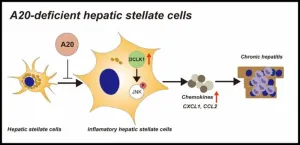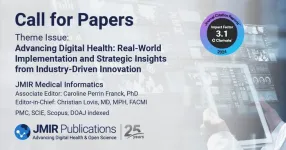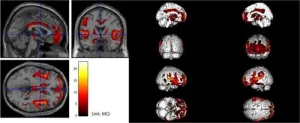(Press-News.org) PHILADELPHIA – A new tool for monitoring immune health patterns over time has revealed how a pair of checkpoint inhibitor therapies works together to recruit new cancer-fighting T cells with every infusion. Findings from the use of the new tool, developed by researchers at the University of Pennsylvania Perelman School of Medicine and Penn Medicine’s Abramson Cancer Center (ACC), were published today in Cancer Cell. The study challenges fundamental assumptions about how a common immunotherapy drug combination activates different types of T cells to defeat cancer and could help researchers more precisely measure immune response in future clinical trials.
Immunotherapy has made immense progress in improving survival for advanced melanoma over the last decade, although researchers are still working to understand why some patients’ cancers respond better than others and to develop therapies that come with less side effects. This study focused on a particular immunotherapy combination that has become a mainstay of melanoma treatment: PD-1 and CTLA-4 checkpoint inhibitors.
A new understanding of T cell response
Immune checkpoint inhibitors work by unleashing T cells to find and kill cancer cells. It was thought that this type of combination immunotherapy works by equipping an army of T cells to recognize and fight cancer throughout the course of treatment. In a sense, the idea was that if this group of T cells stayed strong for long enough, they would conquer cancer, but if they became too depleted, they would lose the battle. The study, which analyzed data from 36 patients treated with immunotherapy for advanced melanoma, found that the combination therapy produces waves of new T cells—known as a clonal response—with each dose, rather than continually strengthening the same pool of T cells.
“We found that after every infusion, you have a new immune response, with a new group of T cells coming in to fight the cancer,” explained senior author Alexander Huang, MD, an assistant professor of Hematology-Oncology and a research investigator with the Tara Miller Melanoma Center at the ACC. “Think about these T cells like an army: for many cancer patients, even when they have tumors growing, experienced T cell fighters are trying to slow down the advance of the enemy cancer cells. We call them ‘exhausted T cells’ because they’ve been fighting so long, but they’re elite because they’re able to survive in a hostile environment and know how to recognize and fight the cancer cells.”
Conventional thought was that certain immune checkpoint blockade therapies would strengthen exhausted T cells, directly rejuvenating them. However, these new data suggest that immune checkpoint blockade actually brings in new recruits from the barracks to fight the cancer. Conversely, there comes a time when the new T cell recruits have all been sent out and the barracks are empty, and this is when immune checkpoint blockade may become less effective.
Previous research has shown that exhausted T cells, the elite fighters, come from a source called progenitor cells. Anti-PD-1 immunotherapy taps into this source and eventually depletes the supply. In the current study, the researchers discovered that that anti-CTLA-4 therapy complements PD-1 checkpoint inhibitors by replenishing the supply of progenitor-exhausted T cells, adding more elite fighters to the ranks.
Evaluating immune response over time
To make these discoveries, the team developed a new algorithm called Cyclone to track immune response and patterns over time by following the unique receptors from individual T cells. Looking at blood samples from the same patients, taken during different points throughout their treatment, the researchers were able to see which T cells moved, remained, or disappeared over each patients’ nine-week course of treatment.
This approach also allows researchers to evaluate the magnitude of response, including how many and what type of immune cells are being activated over time as patients go through treatment. Comparatively, other current single-cell methods of studying immune response provide more of a narrow “snapshot” in time.
“We envision that this more precise method of immune monitoring could be applied to clinical trials in several ways,” Huang said. “For example, it could help researchers better understand how new drugs are impacting the immune system or understand the appropriate dosage needed to produce the necessary biological effect, without having to push to find the ‘maximum tolerated dose’ and potentially expose patients to unnecessary toxicity.”
The research team is planning to apply Cyclone in upcoming clinical trials for new cancer immunotherapy approaches, including neoadjuvant studies where T cells can be tracked in both blood and tumor samples, and new immunotherapy combinations, such as drugs targeting PD-1 and LAG-3, a new type of checkpoint inhibitor therapy.
The lead author of the study was Kevin Wang, a medical student in Huang’s laboratory. The study was supported by the National Institutes of Health, including the Wistar/Penn SPORE in Skin Cancer, (K08CA230157, R01CA273018, RO1CA258113, P50CA174523, P50CA261608, P30CA016520, R01CA244936, P50CA225450, and P30CA016087), the Tara Miller Melanoma Foundation, the Parker Institute for Cancer Immunotherapy, and the Pew-Stewart Scholars Program in Cancer Research.
Editor’s note: Huang has performed consulting work for Immunai and received research funding from Bristol Myers Squibb and Merck.
###
Penn Medicine is one of the world’s leading academic medical centers, dedicated to the related missions of medical education, biomedical research, excellence in patient care, and community service. The organization consists of the University of Pennsylvania Health System and Penn’s Raymond and Ruth Perelman School of Medicine, founded in 1765 as the nation’s first medical school.
The Perelman School of Medicine is consistently among the nation's top recipients of funding from the National Institutes of Health, with $550 million awarded in the 2022 fiscal year. Home to a proud history of “firsts” in medicine, Penn Medicine teams have pioneered discoveries and innovations that have shaped modern medicine, including recent breakthroughs such as CAR T cell therapy for cancer and the mRNA technology used in COVID-19 vaccines.
The University of Pennsylvania Health System’s patient care facilities stretch from the Susquehanna River in Pennsylvania to the New Jersey shore. These include the Hospital of the University of Pennsylvania, Penn Presbyterian Medical Center, Chester County Hospital, Lancaster General Health, Penn Medicine Princeton Health, and Pennsylvania Hospital—the nation’s first hospital, founded in 1751. Additional facilities and enterprises include Good Shepherd Penn Partners, Penn Medicine at Home, Lancaster Behavioral Health Hospital, and Princeton House Behavioral Health, among others.
Penn Medicine is an $11.1 billion enterprise powered by more than 49,000 talented faculty and staff.
END
Researchers from Tokyo Medical and Dental University (TMDU) determine how a protein called A20 can regulate the inflammatory response to suppress chronic hepatitis
Tokyo, Japan – Many individuals worldwide suffer from chronic liver disease (CLD), which poses significant concerns for its tendency to lead to hepatocellular carcinoma or liver failure. CLD is characterized by inflammation and fibrosis. Certain liver cells, called hepatic stellate cells (HSCs), contribute to both these characteristics, but how they are specifically involved in the inflammatory response is not ...
The Microbiology Society, one of the largest microbiology societies in Europe, is pleased to announce a new three year Publish and Read offering with German consortium ZB Med – Information Centre for Life Sciences, available to its 400 member institutions and 2,000 hospitals. This agreement was established in partnership with HARRASSOWITZ, the Society’s representative agency in Germany.
From 2025, member institutions can join this consortium-wide Publish and Read agreement to enjoy discounted pricing. For participating institutions, the ...
Researchers at Nano Life Science Institute (WPI-NanoLSI), Kanazawa University, implement modifications to their high-speed atomic force microscopy that simultaneously improve resolution and speed, while enabling direct measurements of 3D structures to provide conclusive evidence of a contested hydration layer forming as calcite dissolves.
Understanding the dissolution processes of minerals can provide key insights into geochemical processes. Attempts to explain some of the observations during the dissolution of calcite (CaCO3) have led to the hypothesis that a hydration layer forms, although this has been contested. Hydration layers are also ...
A new study has found an answer for a long-lasting question in aging research - Is Alzheimer’s disease-dementia a form of accelerated aging or is there a different path that can lead us to healthier brain aging? In an international effort, the researchers mapped 1.65 million cells from 437 aging brains, and uncovered distinct paths of cellular change in the aging brains, with one leading to Alzheimer’s disease and the other to an alternative form brain aging. They also point to specific cell signatures predicted to advance disease once they appear in the aging ...
Toronto- August 27, 2024 - JMIR Publications invites submissions to a new theme issue titled “Advancing Digital Health: Real-World Implementation and Strategic Insights from Industry-Driven Innovation” in JMIR Medical Informatics, a leading peer-reviewed journal indexed in PubMed with a unique focus on clinical informatics and the digitization of care processes.
The health care landscape is transforming rapidly, driven by technological innovation and the pressing need for more efficient, accessible and patient-centric health care solutions.
Yet, the health IT industry grapples with ...
LOS ANGELES, August 29, 2024 — Yangzhi Zhu, Ph.D., Assistant Professor at the Terasaki Institute for Biomedical Innovation (TIBI), has been awarded the prestigious 2024 NARSAD Young Investigator Grant for his groundbreaking work on a lab-on-a-contact lens (LoCL) system. This innovative technology is designed to monitor mental health by providing real-time, non-invasive tracking of panels of key biomarkers, from the wearer’s tears.
Mental health disorders, such as anxiety and depression, affect nearly a billion ...
A recent case report published in Cyborg Bionic Systems details the diagnosis of Idiopathic Normal Pressure Hydrocephalus (iNPH) using multimodality diagnostic approaches, highlighting significant advancements in medical diagnostics and patient care. The study conducted by a team of researchers from Tianjin Medical University General Hospital, Tianjin, China, presents a comprehensive case study of a 68-year-old male patient diagnosed with iNPH, showcasing the effectiveness of these advanced diagnostic techniques.
iNPH is a condition characterized by the accumulation of cerebrospinal fluid (CSF) causing ventricular dilation, ...
Move over, Sonic. There’s a new spin-jumping champion in town – the globular springtail (Dicyrtomina minuta). This diminutive hexapod backflips into the air, spinning to over 60 times its body height in the blink of an eye, and a new study features the first in-depth look at its jumping prowess.
Globular springtails are tiny, usually only a couple millimeters in body length. They don’t fly, bite or sting. But they can jump. In fact, jumping is their go-to (and only) plan for avoiding predators. And they excel at it – to the naked eye it seems as though they vanish entirely when they take off.
“When globular springtails ...
Highlights:
Salmonella enterica causes disease in 1.2 million people in the U.S. annually.
The most common way people get infected is by consuming contaminated fresh produce.
New research shows that bacterial leaf spot of lettuce and high humidity promote S. enterica growth in lettuce, and climate change is predicted to increase humid periods.
Washington, D.C.—Climate change will increase the risk of the foodborne illness from Salmonella enterica, according to a new study. The research was published today in Applied and Environmental Microbiology, a journal of the American Society for Microbiology.
S. enterica causes disease in 1.2 million people in the ...
Transformations in the global climate system are profoundly destabilizing ecosystems across the Caribbean, with South Florida and Puerto Rico experiencing notable impacts. To address this challenge, researchers from Florida Atlantic University and the University of Puerto Rico (UPR) in Cayey, are turning to ethnography – an in-depth, immersive research method that involves observing and interviewing people in their natural settings.
FAU’s Dorothy F. Schmidt College of Arts and Letters, in collaboration with UPR Cayey, has received a $650,000 grant from ...






